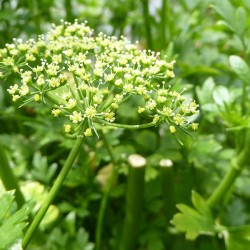Carrots

Botanical name:
Daucus Carota subs. sativus
Description:
There is evidence of carrots been a vegetable already 5000 years ago in what is today’s Afghanistan. The original cultivated plant had a purple root, orange varieties first appeared in Europe in the 1700’s. The 20 to 30 cm long roots range from orange, yellow, purple to white in colour. They have a crisp flesh that tastes earthy and sweet. All of the carrot plant is edible. Their about 40 cm long stems and fern like foliage have a herbaceous flavour with notes of carrot and parsley.
We grow carrots as an annual plant, but it is actually a biennial. If we would leave it in the ground the plant would complete it’s growing cycle in the next spring by developing it’s umbrella like flower clusters and going to seed.
Carrots provide a high content of vitamin A. Orange colored roots offer carotenoids and flavonoids, which are important antioxidants.
How to grow:
Carrots need a fluffy, light, deep and well drained soil. No compost or manure should be added, because it makes carrots fork their roots. They grow in a sunny spot but also in partial shade.
Sow clusters of 3 or 4 seeds 3 mm deep and 10 cm apart directly into the bed. They grow best if the rows are 10 to 15 cm apart as well.
Seedlings appear after a week. Thin out to a 10 by 10 spacing. Do not pull them out to thin them, that would disturb the roots of the remaining carrots. Cut the greens of the ones you want to remove with scissors.
Doesn’t need fertilising.
8 to 10 weeks to harvest.
Growing in the neighbourhood:
Companions are onions, leek, tomato, peas beans and sage. Doesn’t like to live with parsnips, beetroot, dill, brassicas and fennel in the same bed.
Pests and other problems and how we deal with them:
Slugs love young carrot seedlings.
Season:
Carrots are a cool season crop that grow from late Autumn to early Winter or from Late Winter to late Spring.
Seed-saving:
Carrots are biannual, they would need to be left in quite long to have the chance to go to seed.
How to harvest and use:
Carrots are simply pulled as needed and can be harvested over a long period, although if left in the ground too long they may split or grow woody.
Carrots are can be eaten raw and cooked. They are one of the most versatile vegetables in the kitchen. They are great grated in salads and can be pickled and are a good roasted vegetable. Mirepoix, a mix of carrots, onions and celery is the classical base of stocks and soups. Carrots are also great in sweet recipes like carrot cake or the Northern Indian dessert Gaja Halwa.
Carrots pair well with almonds, bacon, butter, celery, parmesan and pecorino, cinnamon, cream, ginger, parsley, potatoes, mushrooms, shallots, tomatoes and vinegar.
Parsley family
Botanical name Umbelliferae or apiaceae also known as the umbel family, carrot family, celery family Features of the parsley family A lot of members of this family are aromatic herbs. Native worldwide, especially in north temperate regions. The name giving feature is that the tiny flowers are grouped together in umbels. The plants in this [more]
Turkish style Carrot Yogurt Dip
A tasty, refreshing dip inspired by Meyhanee restaurant in Balmain. An ideal accompaniment to your favourite summer beverage. The quantities are not critical, you can make it more carroty or more “yoghurt”, or indeed add your own favourite spice flavours. Ingredients 1⁄4 cup extra-virgin olive oil 3 medium to large carrots peeled and grated 1/4 [more]

